ESP KIA STINGER 2018 Repair Manual
[x] Cancel search | Manufacturer: KIA, Model Year: 2018, Model line: STINGER, Model: KIA STINGER 2018Pages: 551, PDF Size: 13.75 MB
Page 473 of 551
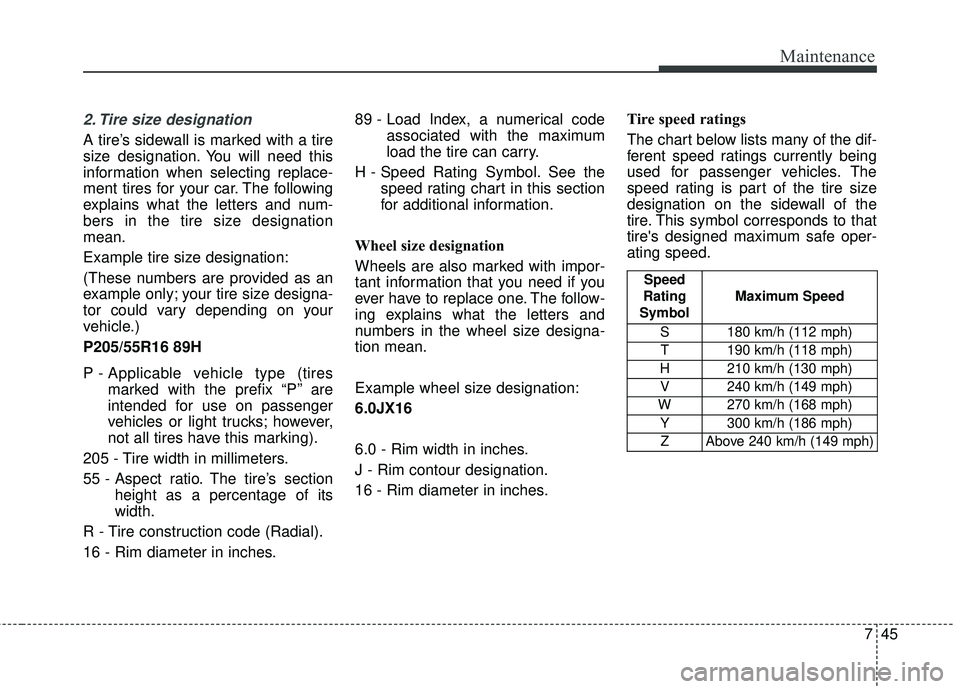
745
Maintenance
2. Tire size designation
A tire’s sidewall is marked with a tire
size designation. You will need this
information when selecting replace-
ment tires for your car. The following
explains what the letters and num-
bers in the tire size designation
mean.
Example tire size designation:
(These numbers are provided as an
example only; your tire size designa-
tor could vary depending on your
vehicle.)
P205/55R16 89H
P - Applicable vehicle type (tiresmarked with the prefix “P’’ are
intended for use on passenger
vehicles or light trucks; however,
not all tires have this marking).
205 - Tire width in millimeters.
55 - Aspect ratio. The tire’s section height as a percentage of its
width.
R - Tire construction code (Radial).
16 - Rim diameter in inches. 89 - Load Index, a numerical code
associated with the maximum
load the tire can carry.
H - Speed Rating Symbol. See the speed rating chart in this section
for additional information.
Wheel size designation
Wheels are also marked with impor-
tant information that you need if you
ever have to replace one. The follow-
ing explains what the letters and
numbers in the wheel size designa-
tion mean.
Example wheel size designation:
6.0JX16
6.0 - Rim width in inches.
J - Rim contour designation.
16 - Rim diameter in inches. Tire speed ratings
The chart below lists many of the dif-
ferent speed ratings currently being
used for passenger vehicles. The
speed rating is part of the tire size
designation on the sidewall of the
tire. This symbol corresponds to that
tire's designed maximum safe oper-
ating speed.
Speed
Rating
Symbol Maximum Speed
S 180 km/h (112 mph) T 190 km/h (118 mph)
H 210 km/h (130 mph) V 240 km/h (149 mph)
W 270 km/h (168 mph) Y 300 km/h (186 mph)Z Above 240 km/h (149 mph)
Page 475 of 551
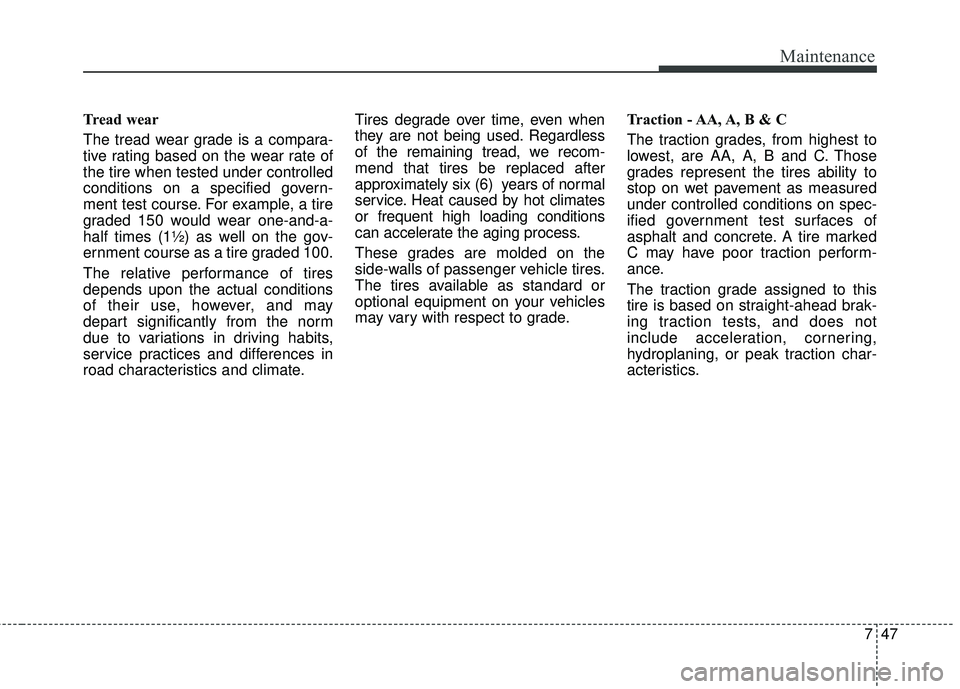
747
Maintenance
Tread wear
The tread wear grade is a compara-
tive rating based on the wear rate of
the tire when tested under controlled
conditions on a specified govern-
ment test course. For example, a tire
graded 150 would wear one-and-a-
half times (1½) as well on the gov-
ernment course as a tire graded 100.
The relative performance of tires
depends upon the actual conditions
of their use, however, and may
depart significantly from the norm
due to variations in driving habits,
service practices and differences in
road characteristics and climate.Tires degrade over time, even when
they are not being used. Regardless
of the remaining tread, we recom-
mend that tires be replaced after
approximately six (6) years of normal
service. Heat caused by hot climates
or frequent high loading conditions
can accelerate the aging process.
These grades are molded on the
side-walls of passenger vehicle tires.
The tires available as standard or
optional equipment on your vehicles
may vary with respect to grade.
Traction - AA, A, B & C
The traction grades, from highest to
lowest, are AA, A, B and C. Those
grades represent the tires ability to
stop on wet pavement as measured
under controlled conditions on spec-
ified government test surfaces of
asphalt and concrete. A tire marked
C may have poor traction perform-
ance.
The traction grade assigned to this
tire is based on straight-ahead brak-
ing traction tests, and does not
include acceleration, cornering,
hydroplaning, or peak traction char-
acteristics.
Page 484 of 551
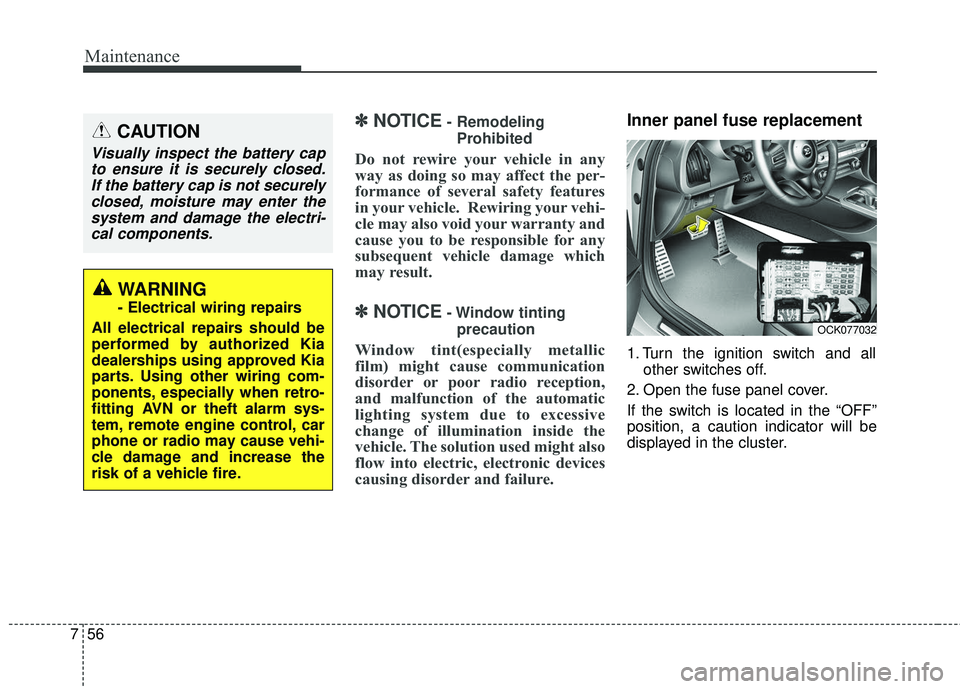
Maintenance
56
7
✽ ✽
NOTICE- Remodeling
Prohibited
Do not rewire your vehicle in any
way as doing so may affect the per-
formance of several safety features
in your vehicle. Rewiring your vehi-
cle may also void your warranty and
cause you to be responsible for any
subsequent vehicle damage which
may result.
✽ ✽ NOTICE- Window tinting
precaution
Window tint(especially metallic
film) might cause communication
disorder or poor radio reception,
and malfunction of the automatic
lighting system due to excessive
change of illumination inside the
vehicle. The solution used might also
flow into electric, electronic devices
causing disorder and failure.
Inner panel fuse replacement
1. Turn the ignition switch and all other switches off.
2. Open the fuse panel cover.
If the switch is located in the “OFF”
position, a caution indicator will be
displayed in the cluster.
CAUTION
Visually inspect the battery cap to ensure it is securely closed.If the battery cap is not securelyclosed, moisture may enter thesystem and damage the electri-cal components.
WARNING
- Electrical wiring repairs
All electrical repairs should be
performed by authorized Kia
dealerships using approved Kia
parts. Using other wiring com-
ponents, especially when retro-
fitting AVN or theft alarm sys-
tem, remote engine control, car
phone or radio may cause vehi-
cle damage and increase the
risk of a vehicle fire.
OCK077032
Page 506 of 551
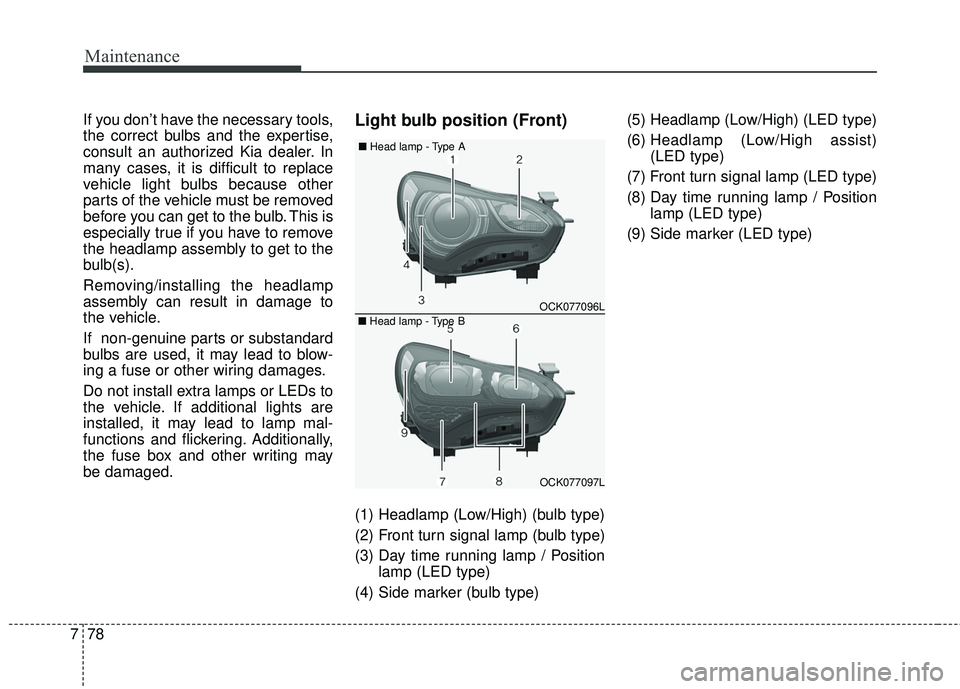
Maintenance
78
7
If you don’t have the necessary tools,
the correct bulbs and the expertise,
consult an authorized Kia dealer. In
many cases, it is difficult to replace
vehicle light bulbs because other
parts of the vehicle must be removed
before you can get to the bulb. This is
especially true if you have to remove
the headlamp assembly to get to the
bulb(s).
Removing/installing the headlamp
assembly can result in damage to
the vehicle.
If non-genuine parts or substandard
bulbs are used, it may lead to blow-
ing a fuse or other wiring damages.
Do not install extra lamps or LEDs to
the vehicle. If additional lights are
installed, it may lead to lamp mal-
functions and flickering. Additionally,
the fuse box and other writing may
be damaged.Light bulb position (Front)
(1) Headlamp (Low/High) (bulb type)
(2) Front turn signal lamp (bulb type)
(3) Day time running lamp / Position
lamp (LED type)
(4) Side marker (bulb type) (5) Headlamp (Low/High) (LED type)
(6) Headlamp (Low/High assist)
(LED type)
(7) Front turn signal lamp (LED type)
(8) Day time running lamp / Position lamp (LED type)
(9) Side marker (LED type)
OCK077096L
OCK077097L
■ Head lamp - Type B
■
Head lamp - Type A
Page 533 of 551
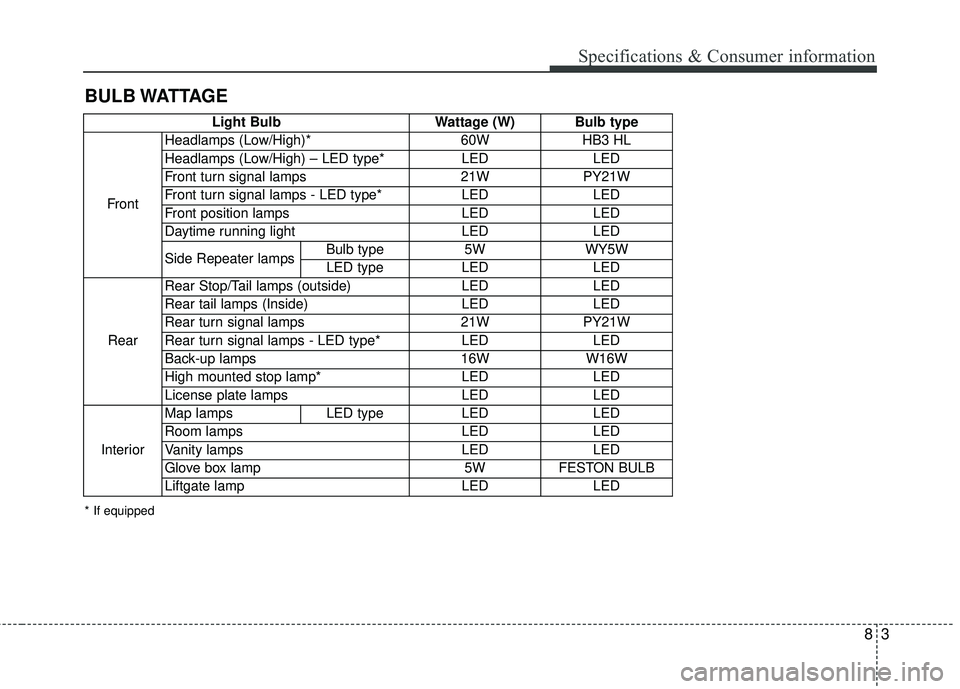
83
BULB WATTAGESpecifications & Consumer information
Light Bulb
Wattage (W) Bulb type
Front Headlamps (Low/High)*
60WHB3 HL
Headlamps (Low/High) – LED type* LEDLED
Front turn signal lamps 21WPY21W
Front turn signal lamps - LED type* LEDLED
Front position lamps LEDLED
Daytime running light LEDLED
Side Repeater lamps Bulb type
5WWY5W
LED type LEDLED
Rear Rear Stop/Tail lamps (outside)
LEDLED
Rear tail lamps (Inside) LEDLED
Rear turn signal lamps 21WPY21W
Rear turn signal lamps - LED type* LEDLED
Back-up lamps 16WW16W
High mounted stop lamp* LEDLED
License plate lamps LEDLED
Interior Map lamps
LED typeLEDLED
Room lamps LEDLED
Vanity lamps LEDLED
Glove box lamp 5WFESTON BULB
Liftgate lamp LEDLED
* If equipped
Page 548 of 551
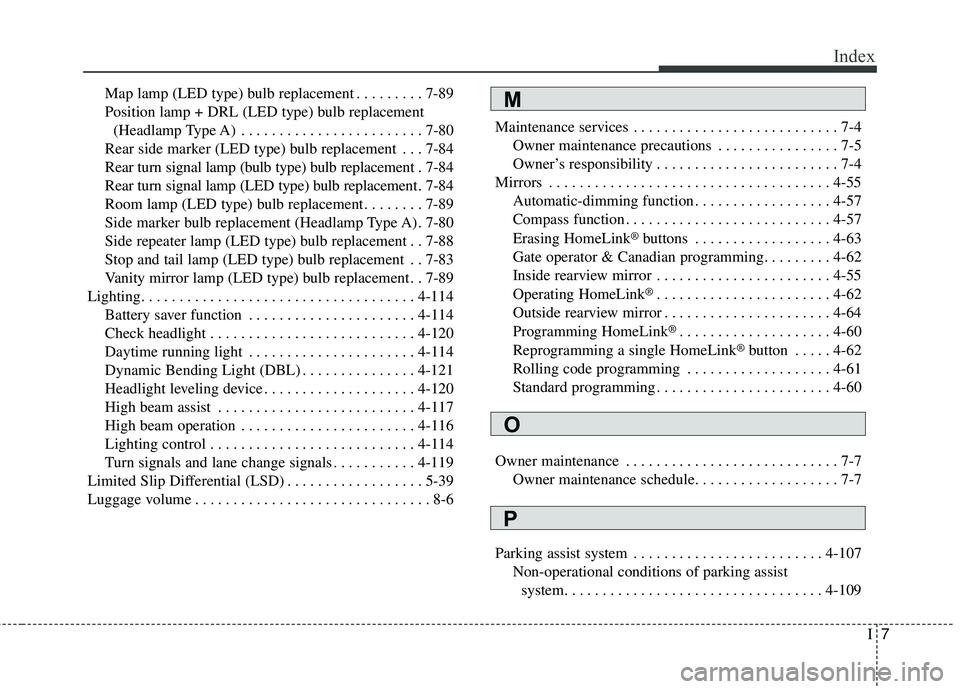
I7
Index
Map lamp (LED type) bulb replacement . . . . . . . . . 7-89
Position lamp + DRL (LED type) bulb replacement (Headlamp Type A) . . . . . . . . . . . . . . . . . . . . . . . . 7-80
Rear side marker (LED type) bulb replacement . . . 7-84
Rear turn signal lamp (bulb type) bulb replacement . 7-84
Rear turn signal lamp (LED type) bulb replacement. 7-84
Room lamp (LED type) bulb replacement . . . . . . . . 7-89
Side marker bulb replacement (Headlamp Type A) . 7-80
Side repeater lamp (LED type) bulb replacement . . 7-88
Stop and tail lamp (LED type) bulb replacement . . 7-83
Vanity mirror lamp (LED type) bulb replacement . . 7-89
Lighting. . . . . . . . . . . . . . . . . . . . . . . . . . . . . . . . . . . . \
4-114 Battery saver function . . . . . . . . . . . . . . . . . . . . . . 4-114
Check headlight . . . . . . . . . . . . . . . . . . . . . . . . . . . 4-120
Daytime running light . . . . . . . . . . . . . . . . . . . . . . 4-114
Dynamic Bending Light (DBL) . . . . . . . . . . . . . . . 4-121
Headlight leveling device . . . . . . . . . . . . . . . . . . . . 4-120
High beam assist . . . . . . . . . . . . . . . . . . . . . . . . . . 4-117
High beam operation . . . . . . . . . . . . . . . . . . . . . . . 4-116
Lighting control . . . . . . . . . . . . . . . . . . . . . . . . . . . 4-114
Turn signals and lane change signals . . . . . . . . . . . 4-119
Limited Slip Differential (LSD) . . . . . . . . . . . . . . . . . . 5-39
Luggage volume . . . . . . . . . . . . . . . . . . . . . . . . . . . . . . . 8-6 Maintenance services . . . . . . . . . . . . . . . . . . . . . . . . . . . 7-4
Owner maintenance precautions . . . . . . . . . . . . . . . . 7-5
Owner’s responsibility . . . . . . . . . . . . . . . . . . . . . . . . 7-4
Mirrors . . . . . . . . . . . . . . . . . . . . . . . . . . . . . . . . . . . . \
. 4-55 Automatic-dimming function . . . . . . . . . . . . . . . . . . 4-57
Compass function . . . . . . . . . . . . . . . . . . . . . . . . . . . 4-57
Erasing HomeLink
®buttons . . . . . . . . . . . . . . . . . . 4-63
Gate operator & Canadian programming. . . . . . . . . 4-62
Inside rearview mirror . . . . . . . . . . . . . . . . . . . . . . . 4-55
Operating HomeLink
®. . . . . . . . . . . . . . . . . . . . . . . 4-62
Outside rearview mirror . . . . . . . . . . . . . . . . . . . . . . 4-64
Programming HomeLink
®. . . . . . . . . . . . . . . . . . . . 4-60
Reprogramming a single HomeLink®button . . . . . 4-62
Rolling code programming . . . . . . . . . . . . . . . . . . . 4-61
Standard programming . . . . . . . . . . . . . . . . . . . . . . . 4-60
Owner maintenance . . . . . . . . . . . . . . . . . . . . . . . . . . . . 7-7 Owner maintenance schedule. . . . . . . . . . . . . . . . . . . 7-7
Parking assist system . . . . . . . . . . . . . . . . . . . . . . . . . 4-107 Non-operational conditions of parking assist system. . . . . . . . . . . . . . . . . . . . . . . . . . . . . . . . . . 4-10\
9
M
O
P